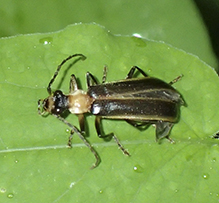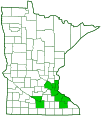yellow-necked soldier beetle
(Podabrus flavicollis)
Conservation • Description • Habitat • Ecology • Distribution • Taxonomy
Conservation Status |
|
|||||||
| IUCN Red List | not listed |
|||||||
| NatureServe | NNR - Unranked |
|||||||
| Minnesota | not listed |
|||||||
Description |
||
Yellow-necked soldier beetle is a fairly common, early season, medium-sized, soldier beetle. It occurs in the United States from Massachusetts to Northern Georgia, west to Minnesota and eastern Texas, and in southern Canada from Quebec to Manitoba. Little is known of the biology and natural history of most soldier beetles, including this one. Adults are active from April to June. They are found in prairies and meadows, usually adjacent to or close to a water source. They are sometimes found in apple orchards. They can be seen during the day on foliage and flowers. They are also active at night and will come to lights. The feeding habits are unknown. They may be carnivorous, feeding on aphids, or omnivorous, feeding on plant pollen and nectar and on aphid honeydew. Adults are ⅜″ to ½″ (10 to 12 mm) in length. The body is long and soft, and it resembles a firefly. It is mostly brownish black (dark) with some yellowish, orangish, or orangish-yellow (pale) areas. The head is narrowed behind the eyes into a distinct neck. The head and neck are exposed, not concealed beneath the plate covering the first segment of the thorax (pronotum). The eyes are large. The antennae are long and have 11 segments. The first antennal segment is pale at the base, dark at the tip. The remaining segments are dark. On the female, the second segment is slightly shorter than the third. On the male, the two segments are about equal in length. The mouthparts are directed forward. The head coloration is variable. The top of the head (vertex) is dark. The neck may be dark or pale. The face is pale, at least in front of the antennae. It is often mostly pale except for a dark band above the mouth. The pronotum is flat and about 1.5 times wider than long. It is entirely pale with no markings. The lateral margins are broadly convex, widest near the middle. The rear corners are angled, not rounded. The surface has large, closely spaced pits (punctate), and is moderately to densely covered with short hairs. The plate between the wing bases (scutellum) is small and pale. The wing covers (elytra) are soft, long, and parallel sided. The tips are broadly rounded. They completely or almost completely cover the abdomen. They are mostly dark except for narrow pale inner (sutural) and outer (lateral) margins. The legs are long, slender, and mostly dark. On all legs, the first segment (coxa), second segment (trochanter), and the base of the third segment (femur) is pale. The end part of each leg (tarsus), corresponding to the foot, has 5 segments. On both sexes the claw at the end of each tarsus is broadly cleft and has one long tooth. |
||
Size |
||
Total length: ⅜″ to ½″ (10 to 12 mm) |
||
Similar Species |
||
Habitat |
||
Prairies and meadows, and sometimes apple orchards |
||
Ecology |
||
Season |
||
April to June |
||
Behavior |
||
Adults are active during the day and are found on foliage and flowers. They are also active at night and will come to lights. |
||
Life Cycle |
||
|
||
Larva Food |
||
|
||
Adult Food |
||
Aphids, or plant pollen, nectar, and aphid honeydew |
||
Distribution |
||||
|
Sources |
|||
| 1/23/2024 | ||||
Occurrence |
||||
Fairly common |
||||
Taxonomy |
|||
Order |
Coleoptera (Beetles) | ||
Suborder |
Polyphaga (Water, Rove, Scarab, Long-horned, Leaf, and Snout Beetles) | ||
Infraorder |
Elateriformia | ||
Superfamily |
Elateroidea (click, firefly and soldier beetles) | ||
Family |
Cantharidae (soldier beetles) | ||
Subfamily |
Cantharinae | ||
Tribe |
Podabrini | ||
Genus |
Podabrus | ||
Synonyms |
|||
|
|||
Common Names |
|||
yellow-collared soldier beetle yellow-necked soldier beetle |
|||
Glossary
Coxa
The first (most proximal) segment of the legs of most arthropods, including all insects, spiders, and crustaceans, and most arachnids. It attaches the leg to the body and connects to the trochanter. Plural: coxae.
Elytra
The hardened or leathery forewings of beetles used to protect the fragile hindwings, which are used for flying. Singular: elytron.
Femur
On insects and arachnids, the third, largest, most robust segment of the leg, coming immediately before the tibia. On humans, the thigh bone.
Pronotum
The exoskeletal plate on the upper side of the first segment of the thorax of an insect.
Scutellum
The exoskeletal plate covering the rearward (posterior) part of the middle segment of the thorax in some insects. In Coleoptera, Hemiptera, and Homoptera, the dorsal, often triangular plate behind the pronotum and between the bases of the front wings. In Diptera, the exoskeletal plate between the abdomen and the thorax.
Tarsus
On insects, the last two to five subdivisions of the leg, attached to the tibia; the foot. On spiders, the last segment of the leg. Plural: tarsi.
Vertex
The upper surface of an insect’s head.
Visitor Photos |
|||||
Share your photo of this insect. |
|||||
| This button not working for you? Simply email us at info@MinnesotaSeasons.com. Attach one or more photos and, if you like, a caption. |
|||||
Babette Kis |
|||||
Podabrus flavicollis (yellow-necked soldier beetle) Podabrus flavicollis, yellow-necked soldier beetle, Barnes Prairie hedgerow, Racine Co., WI. Photographed on June 3, 2021. |
 |
||||
MinnesotaSeasons.com Photos |
|||||
|
|||||

Slideshows |
||

Visitor Videos |
|||
Share your video of this insect. |
|||
| This button not working for you? Simply email us at info@MinnesotaSeasons.com. Attach a video, a YouTube link, or a cloud storage link. |
|||
Other Videos |
|||


Created: 1/23/2024
Last Updated:

